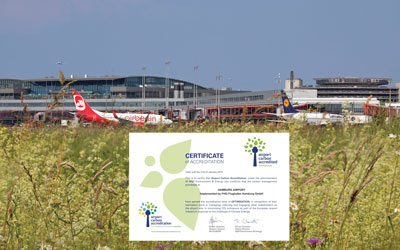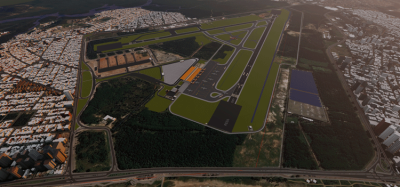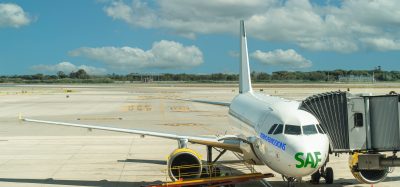More than 25 years of successful, sustainable environmental protection at Hamburg Airport
- Like
- Digg
- Del
- Tumblr
- VKontakte
- Buffer
- Love This
- Odnoklassniki
- Meneame
- Blogger
- Amazon
- Yahoo Mail
- Gmail
- AOL
- Newsvine
- HackerNews
- Evernote
- MySpace
- Mail.ru
- Viadeo
- Line
- Comments
- Yummly
- SMS
- Viber
- Telegram
- Subscribe
- Skype
- Facebook Messenger
- Kakao
- LiveJournal
- Yammer
- Edgar
- Fintel
- Mix
- Instapaper
- Copy Link
Posted: 27 November 2015 | Axel Schmidt and Volker Budde-Steinacker from Hamburg Airport’s Environmental Protection Centre | No comments yet
Hamburg Airport acts as a powerful economic force by not only making a decisive contribution to the successful economic development of northern Germany, but also underlines its responsibility as a modern, environmentally conscious company, well beyond the legal requirements. For International Airport Review, Axel Schmidt and Volker Budde-Steinacker from Hamburg Airport’s Environmental Protection Centre, explains that a number of ‘environmental’ projects have been developed and established at the airport…


In 1989, the Environmental Protection Centre was established at Hamburg Airport, making it the first environment department at an international commercial airport in Germany. When it was established, it meant for the first time that all environmental issues were combined under one roof. In those days, the department was mostly focussed on questions relating to noise protection at the site. But in 1990, the field of activity was expanded to cover environmental matters that were not as much the focus of public attention. This included issues such as water protection, waste disposal, air purity, soil protection, and the ecological management of the airport’s natural spaces. Over the course of the years since, numerous visionary projects have been developed and put into practise.
Treatment of rainfall runoff when polluted with de-icing agents
In the early-1990s, the first system to separate rainfall runoff which was polluted with de-icing agents was developed – at Hamburg Airport. The method involves the use of a TOC measuring system to differentiate between minimally polluted runoff, which can still be fed into the catchment, and heavily polluted runoff, which is fed into the municipal treatment facilities for biological cleansing. Today, this system is used as one of the standard procedures at airports around the world.
Waste separation in terminals and waste treatment
With the opening of its new terminal in 1994, Hamburg Airport was the first airport to introduce waste separation in the public area of its terminals and its Passenger Pier. Today, this experience is a source of valuable and detailed expertise. As the amount of waste generated from the terminals represents only a very small proportion of total waste, this activity is no longer a point of focus.
In consideration of the wide diversity of source and composition of waste, Hamburg Airport now pursues various waste management goals, including:
- Clean and clear separation of waste in interim storage on-site, enabling waste quantities to be better allocated to the individual producers
- Raising the recycling ratio of individual types of waste
- Disposal and documentation in line with legal requirements, in particular for hazardous waste
- Purchase, wherever possible, of products which, at the end of their life, produce non-hazardous, recyclable waste and/or lower quantities of waste.
The goal of these measures is to keep the impact on the environment at a low level, even where quantities of waste rise (where the airport has no influence on waste quantities). This can only be achieved when waste is clearly, and cleanly, separated on-site. This makes comprehensive subsequent recycling possible. To this end, Hamburg Airport chooses specialist ‘disposal partners’ who guarantee recycling. This is verified by Hamburg Airport on the basis of regular visits to these partner firms. Furthermore, personnel and tenants are regularly informed about ways in which to avoid the production of waste, and are motivated to do so.
Noise Protection Programmes
Noise measurements are continually taking place at and around Hamburg Airport. The analysis of the data is also carried out by the Environmental Protection Centre, so that information can be provided promptly to the local community, the authorities, and politicians.
Noise contours are also calculated. These can be used to represent both the current noise quota and the contours of the Noise Protection Programmes. A large proportion of the buildings in the noise protection zones have already been equipped with soundproof windows and ventilators as part of the (mostly) voluntary Noise Protection Programmes. The reason for this is that the airport has already conducted eight Noise Protection Programmes in the local community over the past (almost) 40 years. Hamburg Airport has invested around €40 million in these Noise Protection Programmes which are conducted and processed by the Environmental Protection Centre. The environmental experts on-site are the ‘do-ers’ who take care of the matter directly.
Introduction of an Environmental Management System in line with ISO 14001 and EMAS
For Hamburg Airport, it is very important to achieve a high level of consistency in environmental management. Since July 1998, Flughafen Hamburg GmbH (the operating company) has subjected this system to regular, independent auditing and certification. These external audits may be carried out according to two sets of standards, with international or EU-wide recognition: the globally valid ISO 14.001 norm, and the EU’s EMAS Regulations.
Both standards contain similar elements. However, EMAS prescribes somewhat more detailed public communication of information relating to environmental activities. This takes the form of an Environmental Statement, issued every three years and providing comprehensive details on all environmental-related matters. The Environmental Protection Centre’s internal preparations for these certifications are worthy of mention, involving as they do many other departments.
Mobility Concept 2020
In 2013, the Environmental Protection Centre developed a Mobility Concept for Hamburg Airport. This was ratified by the Executive Board and entered into force the same year. With this Mobility Concept, the airport has set itself ambitious targets. As early as 2020, more than half of all the Hamburg Airport Group’s special vehicles are to be powered by alternative energy sources. When it comes to standard vehicles – cars, small vans and trucks, baggage tugs, and buses – the figure is even more impressive: 100% reliance on environmentally-friendly fuels.
The Mobility Concept specifically requires that all new vehicles purchased will be powered by alternative fuels. For normal vehicles (cars and small vans), this is not problematic, but each case has to be examined individually when it comes to procuring special vehicles. Where the market offers commercial and technically reasonable alternatives, the decision is always made in favour of sustainability. Specifically, this relates to 25 trucks and 171 special vehicles, such as aircraft pushback vehicles. At present, 145 vehicles, representing 35.5% of the entire fleet, are powered by alternative fuels (as of August 2015).
Busy bee colonies report on air quality at Hamburg Airport
Bees have been swarming over Hamburg Airport for 16 years now, providing around 150kg of honey each year. But at the same time, the creatures also serve as ‘bio-detectives’, delivering indications on air pollution in the area. This information supplements the regular air quality measurements. Environmental pollutants can reach a bee colony in different ways: a bee can pick up pollutants directly from water or the air, or plants can absorb pollutants from the air, water, or soil, and pass these on to the bees via nectar and pollen.
Bee colonies cover their territory with great intensity, covering an area of up to 12km². Analyses of the pollen, honey and beeswax shows the composition of pollution in this territory, providing an additional representation of the environmental conditions in the harvesting area at the airport. The bee itself serves as a kind of ‘biofilter’. The creatures are very sensitive to pesticides and other chemicals and mostly die in the event of pollution before reaching their hive. In this project, the bee’s character as indicator and gatherer, combined with the potential accumulation of pollutants in pollen, wax, and honey, enable monitoring and an estimation of emissions in the area under observation.
Hamburg Airport commenced this form of ‘biomonitoring’ at the site in 1999. Each year, at the end of April, up to 12 beehives are put in place at the airport and at a comparator site in a rural area of south-eastern Schleswig-Holstein. The honey is analysed each year by an independent environmental protection laboratory, and based on the parameters and results of the analysis, the honey has always been classified as pollutant-free and completely fit for human consumption. The chemical and physical values are unobjectionable and the honey harvested fulfils the specifications of the German Honey Regulations for table honey as well as the quality regulations of the Federation of German Apiarists (DIB). It has an aromatic and floral taste and scent, typical for honey. There is no trace of kerosene in the taste or smell, despite the expectations of sceptics.
Development and construction of noise protection hangars for international commercial airports
The world’s first enclosed facility for carrying out jet engine test runs on aircraft up to and including a Boeing 747-400, entered operation at Hamburg Airport in 2001. Since then, the Environmental Protection Centre has also made its technical expertise in this field available to other airports. The acoustic calculations at the respective locations are fundamental to this consulting work.
To date, in collaboration with two external engineering firms in Hamburg, noise protection hangars have been constructed at Leipzig Airport (to accommodate A380-sized aircraft) and Zürich Airport (for B747-800-sized aircraft). An A321-size noise protection hangar is currently under construction in Geneva. Further hangars are currently in planning stages.
Consulting services for other airports and companies
Other consulting work for airports cover support in planning approval processes, plus the introduction of environmental management systems.
Measuring energy-saving, air purity, and energy issues
Hamburg Airport believes in modern, environmentally-friendly technologies. This can be seen in the technical buildings facilities, in the vehicle fleet and in work processes. When it comes to energy, Hamburg Airport makes use of visionary technology. Since 2009, CO2 emissions have been reduced by approximately 11,600 tonnes per year – equivalent to the average annual emissions of around 5,800 medium-sized cars. Hamburg Airport made a commitment to the Hamburg Government to reduce CO2 emissions by a further 1,700 tonnes per year, in addition to the 11,600 tonnes already achieved.
A number of measures have resulted in a reduction of CO2 emissions. For instance, for aircraft being handled at the 17 jet bridge positions on the Passenger Pier, the auxiliary power units (APUs) remain switched off. Energy is provided via the Passenger Pier, which at remote parking positions, mobile generators provide the needed energy. This saves around 9,200 tonnes of CO2 per year.
The Thermolabyrinth in Terminal 1 saves 400 tonnes of CO2 every year. External air needed for air conditioning is fed through the cellar of the terminal and the temperatures underground preheat the air in winter and pre-cool it in summer. This reduces the demand on the air conditioning.
The airport central heating plant’s new furnaces have resulted in an increased efficiency level of approximately 85%, lowering the natural gas consumption which in turn reduces CO2 emissions by 120 tonnes per year.
All baggage tugs are powered with natural gas, and there are also six natural gas cars in operation. In total, they save 175 tonnes of CO2 every year and CO2 emissions are 25% lower than those of conventionally-powered vehicles.
Furthermore, Hamburg Airport was one of the first airports in Germany to test hydrogen-powered vehicles, and a traffic optimisation system for the apron is being developed, which is expected to reduce emissions by 10%.
Many of these measures have been developed and advanced by the Environmental Protection Centre, in collaboration with the relevant specialist departments at the airport.
Manpower for environmental protection and sustainability
The Environmental Protection Centre deals with all technical and legal environmental matters at Hamburg Airport. The various Compliance Officer roles defined by German environmental law are centralised here. This allows for the effective processing of all legally mandated obligations and enquiries from the various authorities. Another substantial advantage lies in the simplified communication and decision-making structures. By concentrating environmental competence in a single unit, it has been and remains possible to successfully implement internal projects in close collaboration with the airport’s specialists.
Today, 14 people work at the airport’s Environmental Protection Centre, and the centre also operates the aircraft noise metering equipment and the various computer software necessary for calculating aircraft noise, noise in general, and the distribution of air pollutants. Furthermore, the department also operates the measuring system for monitoring fresh water quality and conducts comprehensive measurement programmes for quality assurance purposes.
Another important field of work relates to organising and running environment events to provide information to interested and effected members of the public, politicians and political bodies, plus the authorities. There are also regular tours and information events on the subject of the airport and the environment.
The promotion of the next generation of specialists in technical environmental protection is also important to the Environmental Protection Centre. This finds expression in the provision of internships and opportunities to complete Masters and Bachelors projects on relevant environmental subjects at the airport. The Environmental Protection Centre has thus been involved in, and continues to be involved in, numerous publicly funded research and development projects. These research projects have looked at such issues as the introduction of hydrogen and fuel cell technology in the aviation industry, the introduction of biofuels in aircraft, the implementation of intelligent energy network structures, and numerous other aspects related to the ‘green airport’ theme.
However, traditional areas of work which have been reconceived as part of the environmental field, relates to green space management, biodiversity, hunting, and birdstrike prevention – including falconry.
Biography
Graduate engineers, Axel Schmidt and Volker Budde-Steinacker, have led the Environmental Protection Centre at Hamburg Airport for the last 25 years. They both studied environmental engineering at the same university in Hamburg. When they started working together at the airport, they divided the responsibilities between themselves. Axel is Head of Department and responsible for all issues relating to noise protection, air purity, and represents the airport on committees and to the public in environmental matters. Volker Budde-Steinacker is concerned with internal technical issues of environmental protection such as water protection, waste management, energy saving, and environmental management.

















